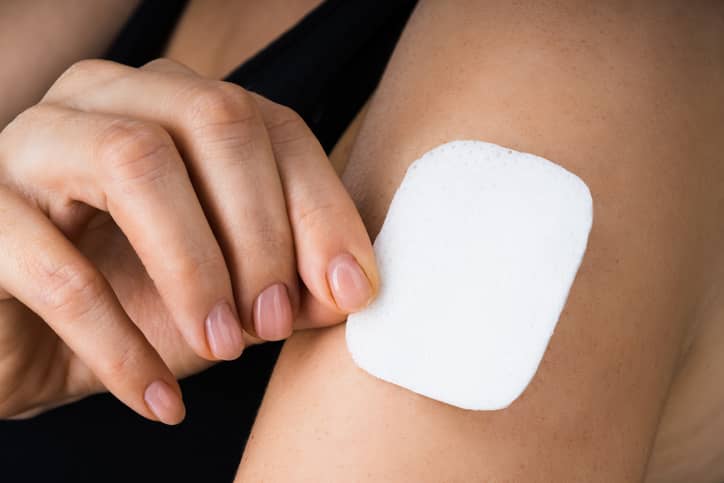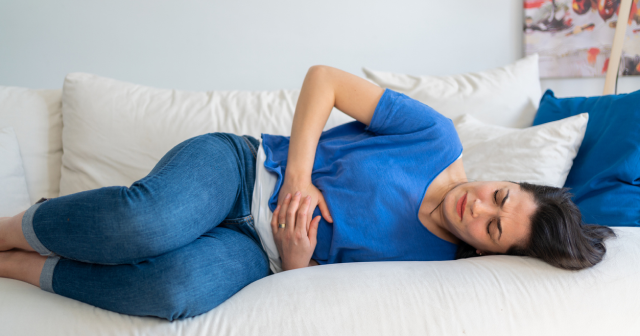What is perimenopause?
The stage leading up to the menopause is called perimenopause. There are usually 2 stages to the perimenopause: the early transition where your periods are mostly regular and the late transition where you may have periods less often, leading up to your final period. Menopause is the time in your life when your periods have stopped and you haven’t had 1 for 12 months.
Changing levels of the hormones oestrogen and progesterone during perimenopause mean you may have irregular, heavier, lighter, shorter or longer periods. Other symptoms may include hot flushes, fatigue and mood swings.
Many people don’t need treatment for perimenopause symptoms, but if you do have symptoms that are upsetting your day-to-day life, there are lots of ways to deal with them. Lifestyle changes and medical treatments like hormone replacement therapy (HRT) can help relieve your symptoms in the run up to menopause.
What are the symptoms of perimenopause?
There are many possible symptoms caused by your changing hormone levels during the menopause, with changes to your periods usually being the first one.
Other common symptoms of perimenopause include:
- hot flushes and night sweats
- sleep problems
- tiredness
- problems with concentrating and memory (known as ‘brain fog’)
- mood swings, anxiety or depression
- hormonal headaches
- joint problems
- dizziness
- a low sex drive (libido)
You may also gain weight despite eating a healthy diet and exercising regularly. Some other less common symptoms may include itchy skin, bladder problems, sore breasts (breast tenderness), heart palpitations, hair loss and vaginal dryness.
Not all people going through the perimenopause experience symptoms to the same degree. It’s possible you may have few – or even no – symptoms during this time.
Read about 8 unusual menopause symptoms to look out for.
When to see a doctor about perimenopause symptoms
You should see a doctor as soon as possible if:
- you’re having very heavy periods, they’re happening more often than every 3 weeks, you’re bleeding after sex or you have any bleeding after the menopause (even if it’s just light spotting)
- you notice unusual discharge from your vagina
- you have any symptoms of a UTI that don’t get better after 2 days
- you feel pain deep inside when you have sex
- you feel low, depressed or anxious and these feelings don’t go away, even after you’ve tried self-care measures
- you have joint pain with swelling or redness
- you have night sweats with weight loss or swollen glands
- you lose weight without trying to
- you’re worried about any side effects from menopause medication you may be taking, like hormone replacement therapy (HRT)
Be sure to see a doctor too, if:
- you’re under 45 and are getting menopausal symptoms
- you have any menopausal symptoms that are upsetting your daily life or worrying you
- your symptoms aren’t getting better with self-care measures, or they keep coming back

What causes perimenopause
As you approach your late 30s, your ovaries start making less oestrogen and progesterone – the hormones that regulate your periods – and your fertility declines. In your 40s, your ovaries start to make less of the hormone oestrogen and no longer release an egg every month (known as ovulation). Eventually, they stop releasing them altogether and your periods stop.
This is a natural event – it is not an illness, although the hormone changes during perimenopause can cause some symptoms that may need treatment in some people.
How is perimenopause diagnosed?
Perimenopause and menopause are usually diagnosed by a doctor who will discuss your signs and symptoms with you and your health history, and possibly do a physical exam. You normally won’t need to have any tests. Perimenopause is likely if you’re in the 45 to 55 age range. (Pregnancy should always be ruled out if this is a possibility).
Menopause is confirmed when you haven’t had your periods for 12 months and there’s no other obvious reason why they’ve stopped. Note that if you're under 50, pregnancy could be still possible for up to 2 years after your periods have stopped.
A doctor can test the level of follicle stimulating hormone (FSH) in your blood – this hormone helps control your menstrual cycle and the production of eggs. If it’s consistently high, this confirms menopause. But this test is rarely necessary except in women who have had a hysterectomy but who still have their ovaries or who are younger than the usual age of menopause (early menopause).
Perimenopause treatment
If you don’t have any perimenopause symptoms, you don’t usually need any treatment. However, you can deal with some symptoms using lifestyle changes, as well as medical and natural treatments.
Lifestyle changes
Eating a healthy diet and regular aerobic exercise, such as swimming, running or brisk walking, can help, as can not smoking and reducing your intake of caffeine and alcohol.
Read more about weight loss during menopause, the best diet for menopause and drinking alcohol during menopause.
Natural treatments
Natural treatments or herbal medicines (based on the use of plants or plant extracts) may help relieve some perimenopause symptoms. Examples include isoflavones (part of a group of plant-based chemicals called phytoestrogens that act like a weaker form of oestrogen in the body), evening primrose oil, St John’s wort, black cohosh and ginseng. There is some limited evidence that isoflavines or black cohosh may help to improve hot flushes, but many herbal treatments are not supported by scientific evidence.
Remember that products labelled ‘natural’ can vary in quality, effectiveness and strength, and cause side effects. Some (such as St John’s wort) may also interfere with conventional medicines like antidepressants, anticonvulsants, anticoagulants and the combined oral contraceptive pill.
Look for the Traditional Herbal Registration (THR) logo on herbal products in the UK and EU (or equivalent programmes elsewhere). This means that the product is approved, the correct dosage and is of high quality. The pack will also contain information about the product. If you’re considering taking a herbal treatment, discuss this with a doctor first.
Complementary treatments are sometimes used alongside conventional medicine (like HRT) to treat perimenopause symptoms. There is more research needed to show that aromatherapy works when it comes to managing your menopausal symptoms, but many women find that it works to relieve the stress and worry associated with it. Homeopathy is sometimes recommended as a treatment for hot flushes but, again, there’s no convincing evidence that this works.

HRT
HRT is the main treatment for perimenopausal symptoms. It helps to replace your falling levels of the hormones oestrogen and progesterone.
The type of HRT you can use depends on your individual situation. If you have a womb (uterus), a combination of oestrogen and progestogen HRT may be recommended by a doctor. This is because oestrogen alone can cause an abnormal thickening of the lining of your uterus and bleeding – adding progesterone can prevent this. If you have had a hysterectomy, you may be offered oestrogen-only HRT.
HRT can be taken as tablets, skin patches, injections, body gel or spray, or vaginal ring, cream or pessary.
Non-hormonal medication
These are treatments, such as clonidine, gabapentin and antidepressants, that may be recommended by a doctor.
Clonidine is a tablet taken 2 or 3 times a day that doesn’t affect your hormone levels (unlike HRT).
Gabapentin is sometimes used to treat hot flushes, although it is more often used to control nerve pain and epilepsy. However, research has shown it can reduce night sweats and hot flushes.
Two types of antidepressants can also be used to treat hot flushes – these are called selective serotonin reuptake inhibitors (SSRIs) and serotonin-noradrenaline reuptake inhibitors (SNRIs). How these work to help with hot flushes isn’t exactly clear, but when they work, they can provide good relief. A doctor can discuss any possible side effects they may have, such as nausea and a lower libido, as well as their potential benefits.
Read more about how to stop hot flushes without HRT and how to enjoy your sex life and orgasm after menopause.
Psychological treatments
Cognitive behavioural therapy (CBT) is a psychological treatment. You may be offered CBT to help treat perimenopause symptoms as it has been shown to be helpful in treating low mood and anxiety related to menopause as well as sleep problems, hot flushes and night sweats.
Outlook: What are the signs that perimenopause is ending?
Perimenopause ends when menopause starts – when you haven’t had a period for 12 months. Although many perimenopausal symptoms such as hot flushes and night sweats are similar to those experienced during menopause, the difference is that you'll still have a period during perimenopause. You may have very irregular or erratic periods in perimenopause, but until you've gone 1 full year without having a period, you're not in menopause.
Your health questions answered
Do I still need to use contraception during the perimenopause?
 Answered by: Dr Roger Henderson
Answered by: Dr Roger HendersonYes, you do. During perimenopause, ovulation may still occur, along with the risk of you becoming pregnant. You can still become pregnant until you’ve had 1 year without your period – or 2 years without a period if you’re under 50. In general, you can stop using contraception at the age of 55. Becoming pregnant after this age is exceptionally rare even if you’re still experiencing menstrual bleeding. If you’re still having regular periods after the age of 55, discuss with a doctor whether you need to use contraception.
Is fatigue a sign of perimenopause
 Answered by: Dr Roger Henderson
Answered by: Dr Roger HendersonFatigue during perimenopause and menopause is common and can be caused by a number of factors. These can include changes in the levels of oestrogen, progesterone, thyroid and adrenal hormones. These help to regulate your energy levels, so you can feel tired as they change or decrease in your body. You can also feel anxious or low in mood, or have regular hot flushes, all of which can make fatigue worse.
What are the first signs of perimenopause?
 Answered by: Dr Roger Henderson
Answered by: Dr Roger HendersonIn the early stages of perimenopause you may still have regular periods. Hot flushes are among the most common symptoms of perimenopause. They can be associated with forgetfulness or problems with concentration. However, because everyone going through perimenopause experiences it differently, the early signs can vary from person to person.
Key takeaways
- perimenopause is the time before menopause when your hormone levels start to fall
- falling hormone levels can trigger symptoms such as night sweats, fatigue and period changes
- perimenopause symptoms vary from person to person
- HRT can be very effective in treating symptoms of perimenopause
- if you have any questions or concerns about perimenopause symptoms, discuss these with a doctor






